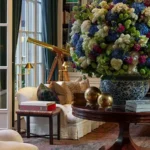
At Milan Design Week 2025, Louis Vuitton stepped into the world of home interiors with a full-scale presentation of its first Home Collections. Set inside the ornate halls of Palazzo Serbelloni, the exhibition introduced an extensive offering of furniture, lighting, decor, textiles, games, and tableware. This debut built on the success of Objets Nomades, first launched in 2012, and expanded Louis Vuitton’s exploration of domestic space from collectible design to complete living environments.
By opening up this new dimension, the Maison reshaped its longstanding focus on craftsmanship and creativity into an immersive experience. Visitors moved from room to room, encountering installations that felt lived-in, expressive, and grounded in material richness. Designers like Patrick Jouin, Cristián Mohaded, Patricia Urquiola, Atelier Biagetti, Jaime Hayón, and Estúdio Campana shaped the vision, offering a range of pieces that combined function with layered detail.

Design as Daily Ritual
The first floor of Palazzo Serbelloni introduced Jouin and Mohaded’s contributions to the new Signature Collection. Their work set the foundation for a thoughtful and composed aesthetic. Pieces from Objets Nomades and the new Home textiles filled the rooms with quiet energy, while Estúdio Campana’s sculptural table football dominated the Petit Foyer.
In the Giangaleazzo room, Mohaded’s Atlas table in onyx anchored the space, surrounded by pieces from the Jungle collection, where animal figures and lush plant motifs brought vibrancy. Nearby, Jouin’s Regatta buffet reflected Louis Vuitton’s attention to material contrast and detail.

Dinner took shape in the Gabrio room. Here, the Atlas table returned in a wood version, topped with the Dolce Vita plates and flanked by the Malle Vaisselier, a trunk that opened to reveal porcelain and glassware. Jaime Hayón’s Botanik ceramics sat nearby in a colorful display, with Atelier Biagetti’s Valse lamp creating rhythm through swirling leather and light. A chrome pinball machine, inspired by Pharrell Williams, added a playful surprise.

The Influence of Fortunato Depero
One room burst with vivid forms in honor of Fortunato Depero, the Italian Futurist artist known for his dynamic graphic style. His influence ran through plates and cushions that turned everyday objects into art. Animals, parrots, pelicans, monkeys, appeared in geometric, joyful forms, drawn from his personal archives. These creations, crafted from linen and glass bead embroidery, brought narrative and color to the collection.

Depero, a painter, poet, and designer, once trained under Giacomo Balla and pushed for a vision of modern life infused with movement and emotion. His work in the exhibition stood as a bridge between historic radicalism and contemporary home aesthetics.

Charlotte Perriand Reimagined
In the Parini room, textile pieces by Charlotte Perriand appeared alongside works by Mohaded and Depero. The Hommage collection brought back Perriand’s minimalist graphic compositions, originally drawn from her 1920s design studio. With textiles inspired by alpine landscapes and ancient tiling patterns, Perriand’s cushions and throws revealed how her early ideas still resonate. Many of these designs, like the Everest and Mirage motifs, translated her love of geometry and nature into fabric form.
Perriand’s architectural vision returned again in the courtyard, where Louis Vuitton reconstructed her 1934 beach house concept, La Maison au Bord de l’Eau. Originally designed as an accessible seaside retreat, the structure embodied simplicity, resourcefulness, and clarity. Rebuilt for the first time in 2013 and now reinstalled, the house anchored the exhibition with a powerful closing gesture.

A Closer Look at Furniture and Form
Throughout the exhibition, the Signature Collection revealed how designers interpreted Louis Vuitton’s visual language. Jouin’s Perfecto armchair featured leather-wrapped curves and details drawn from the Maison’s leather goods, while his Puzzle table used marquetry to transform everyday surfaces into graphic compositions.
Mohaded’s work emphasized form and warmth. His Aventura sofas and armchairs used leather reinforcements inspired by vintage trunks. His Pegase chair, delicate and sculptural, combined wood and leather with quiet grace. The Chacana rug, painted in earthy colors, drew directly from the landscapes of Patagonia.

Patricia Urquiola’s Pecora armchair arrived with a rounded walnut frame and deep comfort, its name referencing a sheep. Her Vibration rug deconstructed the Damier pattern, while her Diago vases and Petalo trays brought leather and glass together in pieces that felt fluid and personal. Atelier Biagetti introduced a new lamp constructed from leather ellipses, and LV Studio offered new seating and tables with concentric wood forms and natural finishes.
Beyond Furniture: Tableware and Games
Louis Vuitton pushed further into domestic rituals through tableware and play. Japanese designer Nendo created black ceramics in swirling forms, while Laboratorio Paravicini painted exotic flora and fauna across Limoges porcelain. Yoko Togashi’s sandblasted glass chargers added a tactile edge to table settings. The Asnières collection, inspired by stained-glass windows in the Vuitton family home, brought Art Nouveau into the mix.
Games offered another dimension. A multifunctional game table allowed for backgammon, chess, and mahjong, constructed in supple leather and solid wood with hidden compartments. These pieces connected with the Maison’s long history of creating leisure objects for travel and the home.




